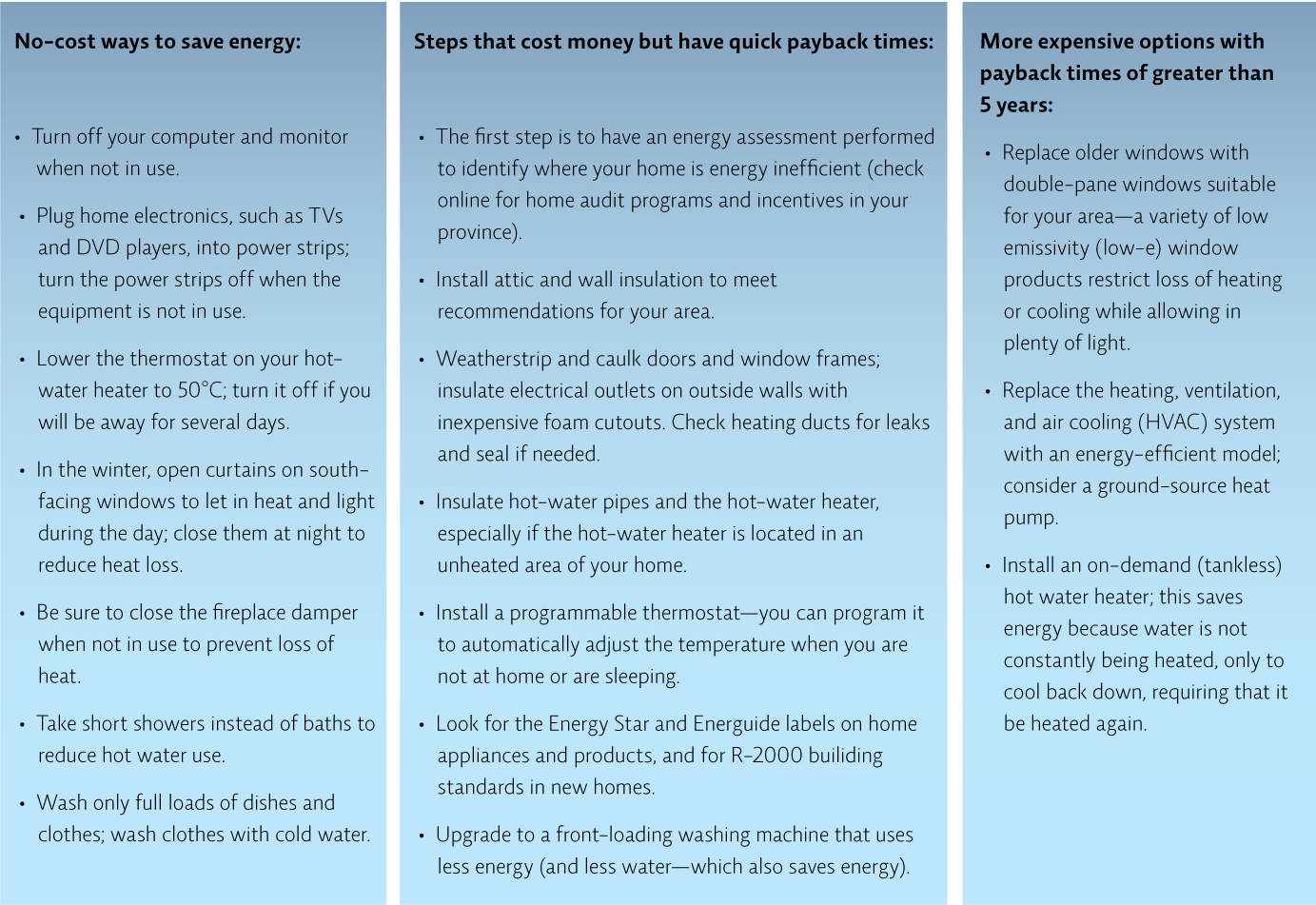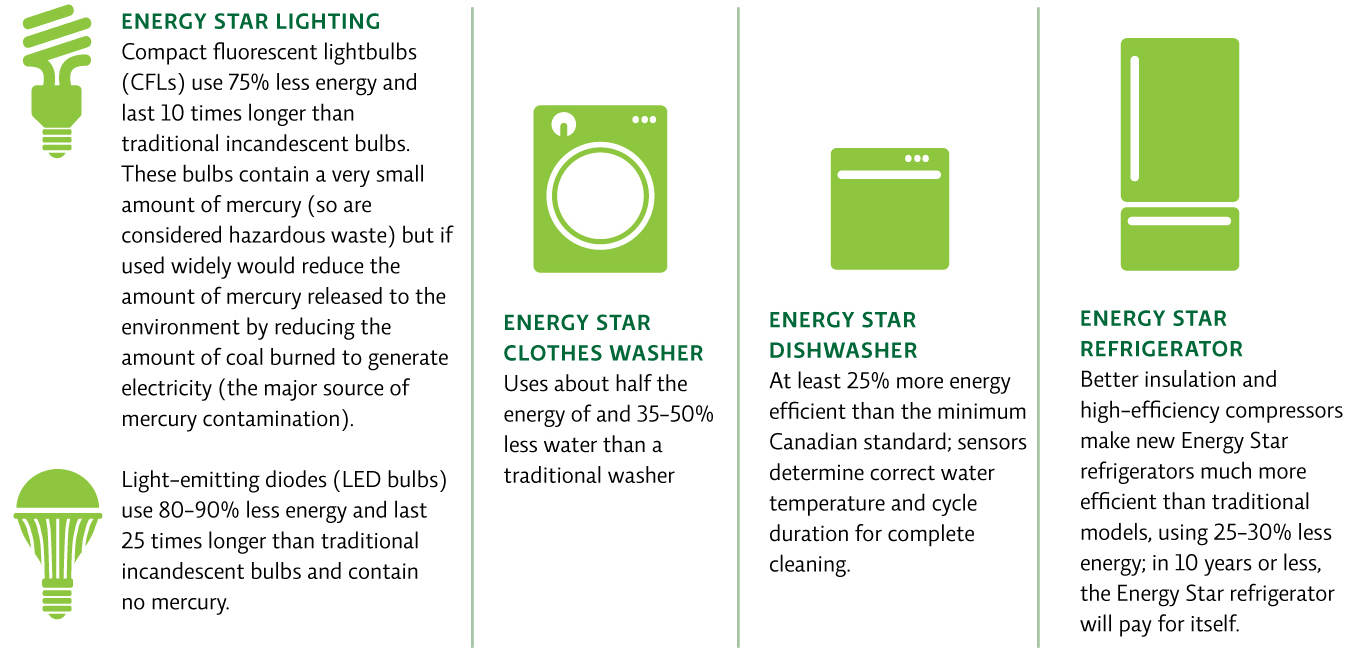24.8 Meeting our energy needs with renewable sources becomes more likely when we pair them with energy conservation measures.
Even though the people of Samsø saw the importance of investing in sustainable energy, they realized that one of the best ways to help achieve energy independence would be to simply use less of it. As energy advisors like to say, the greenest kilowatt is the one you never use. Luckily, there are lots of ways to reduce electricity use right now. [infographic 24.6]

For instance, residents were encouraged to focus on energy efficiency, relying on technology that uses less energy for a given output. In Samsø’s cold climate, one of the first conservation efforts revolved around heating homes, mainly by transitioning away from electrical heaters. Energy home audits pinpointed other steps individuals could take, such as using straw, wood chips, and other sources of biomass for heat. Gas stoves were replaced by more efficient electric stoves; people began heating water using electricity generated by the wind turbines or solar panels. Residents were encouraged to apply for grants toward upgrades that made their homes more energy efficient. Similar programs exist in Canada. (See Chapter 26 for more ways consumers can cut energy use.)
Another basic approach to using less energy relies on conservation—making choices that result in less energy consumption. Much of conservation involves changing people’s behavior; since lighting typically accounts for about 20% of the average home’s electric bill, simply turning off the lights when you leave a room can make a big difference. Other options include studying in a room with ample natural light instead of a dark corner that requires artificial light, and lighting your home with compact fluorescent lights (CFLs) or LEDs (light-emitting diodes), which consume less electricity. [infographic 24.7]

448
In just a few years, the island of Samsø has transformed itself, capturing the attention of countries around the world, impressed by how a small farming community became the most energy efficient place on Earth. By 2005, the island was producing more energy from renewable resources than it was using. This transition has the added benefit of cleaner air—Samsø has reduced its nitrogen and sulphur air pollution by 71% and 41%, respectively, and its CO2 emissions have fallen to below zero, thanks to the fact that the windmills offset more CO2 than their vehicles emit.
Much of that success stems from community members working together to solve their own local problems, says Hermansen. As he told Time magazine in 2008, “People say: ‘Think globally and act locally.’ But I say you have to think locally and act locally, and the rest will take care of itself.”
Select references in this chapter:
Holm, A. et al. 2010. Geothermal Energy International Market Update. Geothermal Energy Association.
Sovacool, B. K. 2009. Energy Policy, 37, Issue 6: 2241–2248.
449
BRING IT HOME: PERSONAL CHOICES THAT HELP
A key component to developing a sustainable society is the use of renewable energies. Renewable energy decreases harmful impacts of mining waste associated with nonrenewable energy, plus reduces the amount of air and water pollution produced when the fuel is processed and burned. The efficiency and availability of renewable energy is rapidly increasing because of the development of new trends and technologies.
Individual Steps
 Contact your energy provider to see if you can purchase a percentage of your energy from a renewable source.
Contact your energy provider to see if you can purchase a percentage of your energy from a renewable source.
 Regardless of your home’s energy source, make sure you are using energy efficiently. Review Infographic 24.6 and visit oee.nrcan.gc.ca/home for more ideas.
Regardless of your home’s energy source, make sure you are using energy efficiently. Review Infographic 24.6 and visit oee.nrcan.gc.ca/home for more ideas.
 If you have an iPhone, download the PVme app to see how many solar panels you would need to meet your household energy needs.
If you have an iPhone, download the PVme app to see how many solar panels you would need to meet your household energy needs.
 A major barrier to solar energy for many people is the cost. For information on tax incentives, rebates, and other programs that make using renewable energy easier, check out oee.nrcan.gc.ca/corporate/statistics/neud/dpa/policy_e/programs.cfm or look for resources in your province.
A major barrier to solar energy for many people is the cost. For information on tax incentives, rebates, and other programs that make using renewable energy easier, check out oee.nrcan.gc.ca/corporate/statistics/neud/dpa/policy_e/programs.cfm or look for resources in your province.
Group Action
 Invest in providing solar energy to lower-income communities; such initiatives are available in several provinces.
Invest in providing solar energy to lower-income communities; such initiatives are available in several provinces.
Policy Change
 Contact your MPs and MPPs and ask them to support or sponsor legislation that provides financial incentives for the purchase of renewable technologies.
Contact your MPs and MPPs and ask them to support or sponsor legislation that provides financial incentives for the purchase of renewable technologies.

450